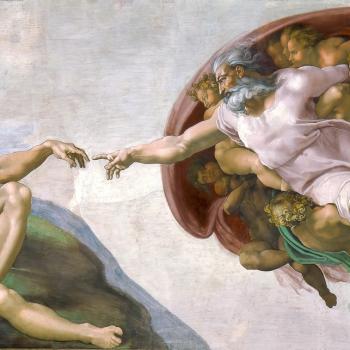Introduction
“Taking God’s name in vain” is not the prerogative of monotheists alone; other gods, too, have been misunderstood and maligned. Take the Hindu trinity, for example. Brahma, basically, is the creator aspect of the divine; Vishnu is the preserver aspect; while Shiva is the destructive aspect. In iconography and imagery, he is sometimes depicted as a fearful “lay-waster”, dealing death and destruction – the master of mayhem. The truth, however, is quite different. Where Brahma is creator, Shiva is re-creator. Where Brahma is the expert at “creation ex nihilo”, bringing into being that which previously did not exist, Shiva is the genius who disassembles old configurations and recombines the constituent elements into new, exciting manifestations.
Let me play around with a few analogies – some scientific, some artistic and some more prosaic.
(A) Dissipative Structures
Ilya Prigogine, a Belgian, Russian-born scientist was awarded the Nobel Prize for Chemistry in 1977 for solving an old problem in science, namely: if the second law of thermodynamics is true – “all systems, left to their own devices, eventually run themselves down into chaos” (e.g., bikes left out in the rain, rust; a steaming cup of coffee left on the kitchen table soon becomes tepid) – then how come more and more complex life forms evolve?
He discovered that systems can reorganize their interior elements, dissipating chaos in the process, and leap-frogging into new and improved versions of themselves. He called this process, Dissipative Structures. That is Shiva energy at work!
(B) Lego
Imagine a little boy with his first box of Lego. Initially, he arranges all of the pieces in a one-dimensional “straight” line that starts in the sitting room and stretches all the way through the kitchen, hallway and into his bedroom. He claps his hands in glee at his wonderful achievement! Some days later, he kicks his masterpiece into heaps which his mother gathers and puts back in the box.
Next week he tumbles them back onto the floor and now he is ready to try his hand at creating – from the very same pieces – a two-dimensional art piece. Perhaps he even manages to spell his name: DANE. That survives for a while and, once more, is taken apart.
Very soon he will discover the third dimension and, from the original pieces, start creating exotic feats of engineering. He is on his way to winning a Young Scientist of The Year award.
This ability to use pre-existing, simple elements to solve significant issues is precisely what allowed the engineers of NASA and the crew of Apollo 13 to survive a near-fatal flaw during their 1970 mission.
Shiva wins again.
(C) Butterflies
Bruce Lipton, a paradigm-busting cell biologist and Steve Bhaerman, a witty political philosopher combined their talents in a book called, Spontaneous Evolution. Very succinctly they tell the story of the caterpillar-into-butterfly odyssey; using it as an allegory for human survival and evolution in our times.
When the caterpillar somehow realizes that he has gone as far as he can go as a caterpillar, he becomes a recluse, building a house about himself that disconnects him completely from the external environment – including food sources. So, he begins to devour his own body, reducing it to goo in the process. Somehow – an embedded Higher Consciousness? – he releases or fashions “imaginal cells” which begin to promote a new program of transmutation. The old cells, however, fight desperately to keep the previous code intact. (Remind you of anything in our corporatocracy-owned, military/industrial-driven 21st century?) But this fight actually strengthens the imaginal warriors, who eventually win the day. The new program is fully installed and operational, and the result is “unimaginable”: a delicate, angel-like, multicolored aeronaut. Nothing is added or taken away; the cells are simply reorganized by a different algorithm.
Let’s hear it for Shiva!
(D) Your humble TV
About 50 years ago I saw a black-and-white portrait of a young woman. On closer inspection, I realized that it had not been done with pencil or charcoal or paint; it had been typed on an old-fashioned Imperial typewriter using the single letter, “x”! Simply clustering the “x’s” at different densities created the perfect image.
That’s, basically, what your TV screen does, except the “x’s” are pixels. If your screen were divided up into tiny boxes of 600 rows by 420 columns, you’d get over a quarter of a million spaces or pixels, each of which can either be on/live/occupied (a “1”) or off/dead/unoccupied (a “0”). The almost infinite number of resulting combinations can be coded to represent letters, numbers, colors, sounds, symbols etc. Thus, everything you read or hear or see on your screen is simply a sequence of filled or empty pixels. This is based on Boolean algebra – a system devised in the 1850’s by the professor of mathematics – George Boole – at my Alma Mater, University College Cork, part of the National University of Ireland.
(E) Express your DNA
You – or, at least, your “spacesuit” – and, indeed, all life forms, are simply the hardcopy of an online program that, instead of “0’s” and “1’s”, uses four nucleotides – A, C, T and G. Change the sequence and you get the blueprint for anything on the planet, from hermit crabs in the ocean to hermit mystics in the Himalayas. No need to add or subtract; simply rearrange.
(F) Learning to write
When the Phoenicians invented the alphabet – around 1200 BCE – they managed to reduce the unwieldly (and very difficult to master) cuneiform of Sumeria and hieroglyphics of Egypt to 22 simple characters representing the basic phonemes of which all 7,000 spoken human languages are formed. The Greeks, Romans and Hebrews quickly jumped aboard. The ancient Celts reduced it further to 20 characters in their written language called, Ogham (pronounced Om), while English bumped it up to 26 characters.
All Western and middle-Eastern written texts, from Shakespeare to “How to assemble a sofa from IKEA” are just combinations of these 20-plus symbols.
(G) Pacha Mama and her children
Shiva has been really busy in our times; the changes are coming fast and furious; somebody once quipped, “things are getting better and better, and worse and worse, faster and faster.” Shiva is committed to evolution. But here’s the thing: if Shiva has favorites, it most certainly is not those immersed in greed, violence and hoarding. Human hubris is exactly the opposite of what he rewards. His favorites are the life forms that are sensitive and responsive to the feedback loop of their own footprint on the belly of Pacha Mama. Those life forms that walk with humility and grace will ultimately thrive; those who grab and despoil will wind up in evolutionary cul-de-sacs.
All of us 7.5 billion humans are currently filling in our Boolean “0’s” (fear) and “1’s” (love) on the screen of our Reality TV. The question is, will there be enough love pixels to put us on the road less travelled? Will there be enough imaginal cells to release the angel-like aeronaut in us?
Shiva really doesn’t mind which species “wins” – as long as Love is the victor.













